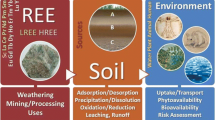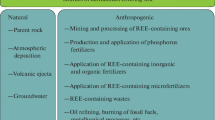Abstract
Despite the name, rare earth elements are relatively abundant in soil. Therefore, these elements might interact with biosphere during the history of life. In this study, we have examined the effect of rare earth ions on the growth of bacteria, fungi and soil nematode. All rare earth ions, except radioactive promethium that we have not tested, showed antibacterial and antifungal activities comparable to that of copper ions, which is widely used as antibacterial metals in our daily life. Rare earth ions also have nematicidal activities as they strongly perturb the embryonic development of the nematode, Caenorhabditis elegans. Interestingly, the nematicidal activity increased with increasing atomic number of lanthanide ions. Since the rare earth ions did not show high toxicity to the human lymphoblastoid cell line or even stimulate the growth of the cultured cells at 1 mM, it raised the possibility that we can substitute rare earth elements for the antibacterial metals usually used because of their safety.




Similar content being viewed by others
References
Wyttenbach A, Tobler L, Furrer V (1996) The concentration of rare earth elements in plants and in the adjacent soils. J Radioanal Nucl Chem Artic 204:401–413
Liang T, Li K, Wang L (2014) State of rare earth elements in different environmental components in mining areas of China. Environ Monit Assess 186:1499–1513
Aruguete DM, Aldstadt JH, Mueller GM (1998) Accumulation of several heavy metals and lanthanides in mushrooms (Agaricales) from the Chicago region. Sci Total Environ 224:43–56
Bayer ME, Bayer MH (1991) Lanthanide accumulation in the periplasmic space of Escherichia coli B. J Bacteriol 173:141–149
Rogers HJ, Woods VE, Synge C (1982) Antibacterial effect of the scandium and indium complexes of enterochelin on Escherichia coli. J Gen Microbiol 128:2389–2394
Qizhuang H, Jing Y, Hui M, Hexing L (2006) Studies on the spectra and antibacterial properties of rare earth dinuclear complexes with l-phenylalanine and o-phenanthroline. Mater Lett 60:317–320
Selvaraj S, Krishnaswamy S, Devashya V, et al. (2014) Flavonoid-metal ion complexes: a novel class of therapeutic agents. Med Res Rev 34:677–702
Hirano S, Suzuki KT (1996) Exposure, metabolism, and toxicity of rare earths and related compounds. Environ Health Perspect 104:85–95
Oral R, Bustamante P, Warnau M, et al. (2010) Cytogenetic and developmental toxicity of cerium and lanthanum to sea urchin embryos. Chemosphere 81:194–198
Pagano G, Guida M, Tommasi F, Oral R (2015) Health effects and toxicity mechanisms of rare earth elements—knowledge gaps and research prospects. Ecotoxicol Environ Saf 115:40–48
Jenkins W, Perone P, Walker K, et al. (2011) Fibroblast response to lanthanoid metal ion stimulation: potential contribution to fibrotic tissue injury. Biol Trace Elem Res:621–635
Yamamoto A, Hirouchi T, Mori T, et al. (2007) Biochemical and biological properties of DNA photolyases derived from utraviolet-sensitive rice cultivars. Genes Genet Syst 82:311–319
Brenner S (1974) The genetics of Caenorhabditis elegans. Genetics 77:71–94
Odajima C, Nakamura T, Nakamura M, et al. (2014) Role of nucleotide excision repair or base excision repair in movement of various n-alkylated bases, investigated by the comet assay. Genes Environ 36:10–16
Nakamura T, Nakai M, Ookubo K, et al. (2011) Genotoxicity-suppressing effect of aqueous extract of Connarus ruber cortex. Genes Environ 33:81–88
Fujimori T, Jencks WP (1990) Lanthanum inhibits steady-state turnover of the sarcoplasmic reticulum calcium ATPase by replacing magnesium as the catalytic ion. J Biol Chem 265:16262–16270
Burroughs SE, Horrocks WD, Ren H, Klee CB (1994) Characterization of the lanthanide ion-binding properties of calcineurin-B using laser-induced luminescence spectroscopy. Biochemistry 33:10428–10436
Zhang H, He X, Bai W, et al. (2010) Ecotoxicological assessment of lanthanum with Caenorhabditis elegans in liquid medium. Metallomics 2:806–810
Pang X, Li D, Peng A (2002) Application of rare-earth elements in the agriculture of China and its environmental behavior in soil. Environ Sci Pollut Res Int 9:143–148
Kumari M, Singh SP, Chinde S, et al. (2014) Toxicity study of cerium oxide nanoparticles in human neuroblastoma cells. Int J Toxicol 33:86–97
Acknowledgments
This study was supported in part by the Japan Society for the Promotion of Science (JSPS) KAKENHI with a Grant-in-Aid for Scientific Research (C) (B264207180) to TW and AY. The authors would like to thank Dr. Masuo Okada of Hachinohe National College of Technology for his valuable suggestions.
Author information
Authors and Affiliations
Corresponding authors
Additional information
Tokumitsu Wakabayashi and Ayumi Ymamoto contributed equally to this study
Rights and permissions
About this article
Cite this article
Wakabayashi, T., Ymamoto, A., Kazaana, A. et al. Antibacterial, Antifungal and Nematicidal Activities of Rare Earth Ions. Biol Trace Elem Res 174, 464–470 (2016). https://doi.org/10.1007/s12011-016-0727-y
Received:
Accepted:
Published:
Issue Date:
DOI: https://doi.org/10.1007/s12011-016-0727-y




